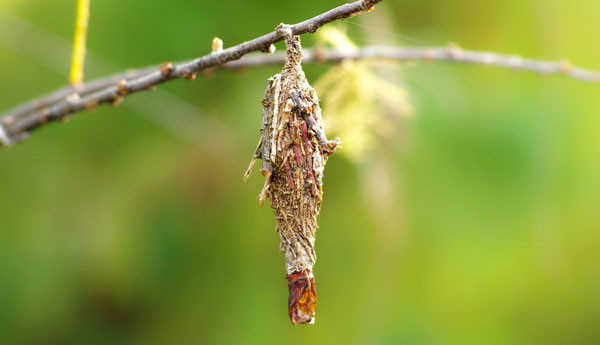
Notice a large section of your plant-life getting torn apart by sticky sacks of worms, year after year? You likely have a bagworm infestation, but this is the year to put an end to the tree-borne plant-bandits. Read on for some tips on how to remove these pests from sight and mind.
Seasonal Skirmish
The trick with bagworms is when to start targeting them. Good news for y’all, that time of year is May, when they hatch. Bagworms tend to winter in bags pre-woven by the previous years females. Once the worms hatch–again, think May or early June, depending on where you reside–they crawl from their sacks and wreak absolute havoc on your trees until sometime round August.
Once August hits, they begin constructing new bags, and eventually bury themselves in them as pupae. Come September, the females release a hormone that attracts males, who will then journey from their bag to female bags, where they mate and the cycle begins again, but this time with more worms.
The trick, therefore, is to get to these pests before they have a chance to multiply. Now of course, as the above lifecycle suggests, an ideal time to start culling them is in the fall, when you can hand-pick dormant sacks out of the trees. This can be a little tedious if you have a lot of nests, however. Luckily, in May, you can target the larvae, which is a tad easier.
Treatment Tactics
Obviously insecticides will work on bagworms, and in May, before they are spreading outside their nest, it will be most effective. Products using malathion, diazinon or carbaryl are all good choices. If you want to go all-natural, its gonna take a little more work.
The main natural predator for bagworms is birds–sparrows in particular. Attract a lot of sparrows to your yard, and the problem will slowly sort itself. Sparrows appreciate water at ground level, thickets for nesting, and ample shelter. Brush piles and shrubs are a golden ticket, as are some patches of powdery, dusty ground for the birds’ own parasite control (through dust bathing).
A second option is bacterial. Bacillus thuringiensis can control the worms, but its imperative it is applied as soon as the eggs hatch in spring, before the larvae grow large. Apply with a garden sprayer every week until the bagworms disappear. Try to spray in the early morning or after the sun sets, as UV rays will greatly degrade these sprays.
While the sparrows are certainly the most whimsical and attractive option, it is likely the least effective. While a larger sparrow population can certainly wear down bagworm numbers over the seasons, they are unlikely to clear your infestation completely (or almost completely). In my experience, insecticides or bacterial spray (like Monterey LG6332 Bacillus Thuringiensis) are really the only way to go. Do be aware though, you shouldn’t use these anywhere near where you are promoting butterfly colonies, as the sprays will target caterpillars indiscriminately.
Good luck with the pesky little buggers (no pun intended). While you can likely destroy a good number with the methods detailed above, they are near impossible to eradicate entirely. But the earlier you get after them, the better your odds, so get on it!
A humble homesteader based in an undisclosed location, Lars Drecker splits his time between tending his little slice of self-sustaining heaven, and bothering his neighbors to do his work for him. This is mainly the fault of a debilitating predilection for fishing, hunting, camping and all other things outdoors. When not engaged in any of the above activities, you can normally find him broken down on the side of the road, in some piece of junk he just “fixed-up.”

David Setliff says
Arkansas your ‘bagworm’ is a tent caterpillar. True bagworms are always in the web bag except at hatch til they spin one and the males during mating. Also permethrin or a pyrethroid is a very effective but short duration control Less effect on other insects.
DAVID PYRON says
Our NW Arkansas bagworms have been out and active now for about 2 weeks and are actively stripping tree tops and the furry worms are crawling all over the driveway and patio! Thanks for the tips and will continue our feeders for our sparrows.